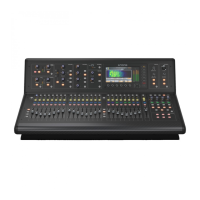104 M32 - Digital Console User Manual 105
Stereo Imager
A Stereo Imager is typically used to control the placement of a signal within the stereo eld during mixdown or mastering.
The M32’s Stereo Imager will lend a professional quality to your live and recorded performances.
The BALANCE rotary control allows you to emphasise the mono and stereo components of the input signal. The mono and
stereo signals can be panned independently with the MONO PAN and STEREO PAN controls. OUT GAIN is used to com-
pensate for level changes resulting from the eect. The phase can also be shifted using the shelving rotary controls. Select
the frequency and bandwidth (Q) using the corresponding rotary controls, then adjust the gain with SHV GAIN.
Edison EX1
The Edison EX1 is an unbelievably powerful psycho-acoustic processor, which allows you to completely manipulate all spa-
tial parameters of the stereo image – such as width and depth – in a way never before possible. You can widen or narrow
the stereo spread, bring instruments to the front or move them to the background, and make corrections to the stereo
image – even on a nished master. Inspired by the Behringer Edison EX1.
St Spread increases the perceived width of the audio eld over which the signal is present. Balance simply adjusts the
levels between the left and right channels, and Center Dist moves the audio source back and forth in the perceived audio
eld.
Sound Maxer
The SOUND MAXER restores natural brilliance and clarity to any audio signal by adjusting the phase and amplitude in-
tegrity to reveal more of the natural texture of the sound, which is often hidden when using some eects and equalisers.
Inspired by Sonic Maximizer 482i.
Use LO CONTOUR to determine the curve on which the PROCESS control is eective. GAIN determines how much of the
input signal passes through the eect.
Dual Guitar Amp / Stereo Guitar Amp
Modelled after the Tech 21 SansAmp, the Stereo / Dual Guitar Amp simulates the sound of plugging into a real guitar amp.
From shimmering cleans to saturated crunch, the M32’s Stereo / Dual Guitar Amp allows an electric guitar player to sound
great without using an amp on stage.
The PREAMP rotary control adjusts the amount of input gain prior to the band-specic distortion adjustment. BUZZ
adjusts the low-end breakup, PUNCH adjusts the midrange distortion, and CRUNCH tailors the high-frequency content
and distortion for smooth or cutting notes. The DRIVE rotary control simulates the amount of power amp distortion from
a tube amp. The LOW and HIGH rotary controls allow EQ adjustment independent of distortion content, and the overall
output is controlled by the LEVEL rotary control. The CABINET simulation can be bypassed if the guitarist is already using
a real cabinet, which allows the eect to function like a boost or distortion pedal. The Dual Guitar Amp allows the left and
right channels to be adjusted independently.
www.theaudiospecialists.eu

